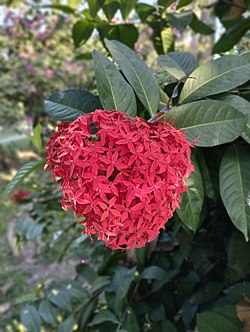Biology:Ixora
| Ixora | |
|---|---|

| |
| Chinese ixora | |
| Scientific classification | |
| Kingdom: | Plantae |
| Clade: | Tracheophytes |
| Clade: | Angiosperms |
| Clade: | Eudicots |
| Clade: | Asterids |
| Order: | Gentianales |
| Family: | Rubiaceae |
| Subfamily: | Ixoroideae |
| Tribe: | Ixoreae |
| Genus: | Ixora L. |
| Type species | |
| Ixora coccinea | |
| Species | |
|
around 544, see text | |
| Synonyms[1] | |
Ixora is a genus of flowering plants in the family Rubiaceae.[1] It is the only genus in the tribe Ixoreae. It consists of tropical evergreen trees and shrubs and holds around 544 species.[2] Though native to the tropical and subtropical areas throughout the world, its centre of diversity is in Tropical Asia. Ixora also grows commonly in subtropical climates in the United States, such as Florida where it is commonly known as West Indian jasmine.
Name
Ixora is Latinized from Ishwara, a name for the Hindu god Shiva, and the genus was formally created by Linnaeus in 1753,[3] as it was noted by Hendrik van Rheede that the flowers of what he noted as schetti (and named by Rheede as Ixora coccinea) were offered in temples in the Malabar.[4][5][6]
Other common names include viruchi, kiskaara, kepale, rangan, kheme, ponna, chann tanea, techi, pan, siantan, jarum-jarum/jejarum, cây trang thái,[7] jungle flame, jungle geranium, and cruz de Malta, among others.
Botany
The plants possess leathery leaves, ranging from 3 to 6 inches in length, and produce large clusters of tiny flowers in the summer. Members of Ixora prefer acidic soil, and are suitable choices for bonsai. It is also a popular choice for hedges in parts of South East Asia. In tropical climates, they flower year round and are commonly used in Hindu worship, as well as in ayurveda and Indian folk medicine.
In Brazil , fungal species Pseudocercospora ixoricola was found to be causing leaf spots on Ixora coccinea.[8] Then in 2018, in Taiwan, during a fungal study, it was found that plant pathogens of Pseudopestalotiopsis ixorae and Pseudopestalotiopsis taiwanensis caused leaf spots on species of Ixora, which is a popular garden plant in Taiwan.[9]
Selected species
- Ixora albersii K.Schum.
- Ixora backeri Bremek.
- Ixora beckleri Benth.
- Ixora brevipedunculata Fosberg
- Ixora calycina Thwaites
- Ixora chinensis Lam.
- Ixora coccinea L.
- Ixora elongata B.Heyne ex G.Don
- Ixora euosmia K.Schum.
- Ixora finlaysoniana Wall. ex G.Don
- Ixora foliosa Hiern
- Ixora johnsonii Hook.f.
- Ixora jucunda Thwaites
- Ixora killipii Standl.
- Ixora lawsonii Gamble
- Ixora malabarica (Dennst.) Mabb.
- Ixora margaretae (N.Hallé) Mouly & B.Bremer
- Ixora marquesensis F.Br.
- Ixora mooreensis (Nadeaud) Fosberg
- Ixora nigerica Keay
- Ixora nigricans R.Br. ex Wight & Arn.
- Ixora ooumuensis J.Florence
- Ixora panurensis Müll.Arg.
- Ixora pavetta Andr.
- Ixora peruviana (Spruce ex K.Schum.) Standl.
- Ixora pudica Baker
- Ixora raiateensis J.W.Moore
- Ixora raivavaensis Fosberg
- Ixora rufa Müll.Arg.
- Ixora saulierei Gamble
- Ixora setchellii Fosberg
- Ixora st-johnii Fosberg
- Ixora stokesii F.Br.
- Ixora temehaniensis J.W.Moore
- Ixora ulei K.Krause
- Ixora umbellata Valeton
- Ixora yavitensis Steyerm.
Gallery
References
- ↑ 1.0 1.1 "Ixora L., Sp. Pl.: 110 (1753).". Plants of the World Online. Royal Botanic Gardens, Kew. 2022. https://powo.science.kew.org/taxon/urn:lsid:ipni.org:names:30043713-2#synonyms.
- ↑ "Ixora L.". The World Flora Online Consortium. 2022. http://www.worldfloraonline.org/taxon/wfo-4000019411#children.
- ↑ Reynolds, S.T.; Forster, Paul I. (2006). "A taxonomic revision of Ixora L. (Rubiaceae: Ixoroideae) in Australia". Austrobaileya 7 (2): 253–278. ISSN 0155-4131. https://www.jstor.org/stable/41739031.
- ↑ Don, George (1834). [Ixora A General System of Gardening and Botany: Founded upon Miller's Gardener's Dictionary, and Arranged According to the Natural System]. 3. London, England, UK: C. J. G. and F. Rivington. p. 570. Ixora.
- ↑ Rheede, Hendrik van (1679). Hortus malabaricus. Volume 2. pp. 17-18. https://www.biodiversitylibrary.org/page/463765.
- ↑ Fosberg, F. R.; Sachet, Marie-Hélène (1989). "Lectotypification of Ixora coccinea L. (Rubiaceae)". Taxon 38 (3): 486–489. doi:10.2307/1222302. ISSN 0040-0262. https://www.jstor.org/stable/1222302.
- ↑ "Cây Trang Thái" (in Vietnamese). 2015. https://vuoncay.vn/danh-muc/cay-cong-trinh/cay-hoa-kieng-cay-trong-vien/cay-trang-thai/.
- ↑ Alves, J.; Barreto, R. (2010). "Pseudocercospora ixoricola causing leaf spots on Ixora coccinea in Brazil.". Plant Dis 94 (2): 278. doi:10.1094/PDIS-94-2-0278C. PMID 30754286.
- ↑ Tsai, Ichen; Maharachchikumbura, Sajeewa S. N.; Hyde, Kevin D.; Ariyawansa, Hiran A. (May 2018). "Molecular phylogeny, morphology and pathogenicity of Pseudopestalotiopsis species on Ixora in Taiwan". Mycological Progress 17 (8): 941–952. doi:10.1007/s11557-018-1404-7.
Wikidata ☰ Q2717258 entry
 |






















